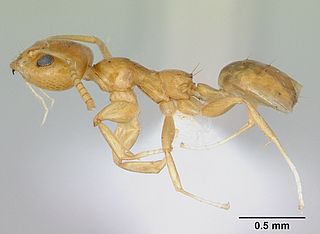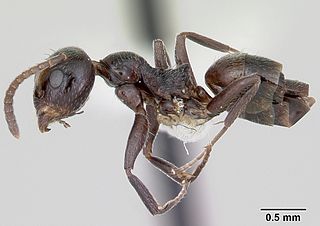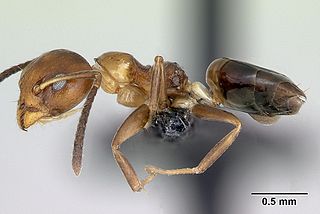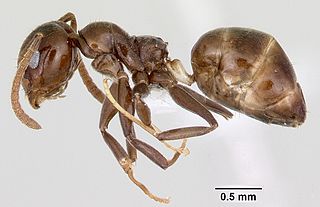
Dolichoderinae is a subfamily of ants, which includes species such as the Argentine ant, the erratic ant, the odorous house ant, and the cone ant. The subfamily presents a great diversity of species throughout the world, distributed in different biogeographic regions, from the Palearctic, Nearctic, Afrotropical region and Malaysia, to the Middle East, Australian, and Neotropical regions.

Iridomyrmex, or the rainbow ant is a genus of ant first described by Austrian entomologist Gustav Mayr in 1862. He placed it in the subfamily Dolichoderinae of the family Formicidae. There are 79 described species and five fossil species. Most of these ants are native to Australia; others are found in several countries and islands in Asia and other areas in Oceania, and they have been introduced to Brazil, New Zealand and the United Arab Emirates. Fossil species are known from China, France and the United States.

Axinidris bidens is a species of ant in the genus Axinidris. Described by Shattuck in 1991, the species is endemic to the Central African Republic, Ghana and Kenya.

Axinidris gabonica is a species of ant in the genus Axinidris. Described by Snelling in 2007, the species is known to inhabit forests in Gabon.
Axinidris ghanensis is a species of ant in the genus Axinidris. Described by Shattuck in 1991, the species is endemic to Ghana and Uganda, based on two collections.
Axinidris hylekoites is a species of ant in the genus Axinidris. Described by Shattuck in 1991, the species is endemic to Ghana, where it was only observed in a rotten tree branch.

Axinidris hypoclinoides is a species of ant in the genus Axinidris. Described by Santschi in 1919, collected specimens are only known to be from forestry regions in several African countries.
Axinidris icipe is a species of ant in the genus Axinidris. Described by Snelling in 2007, the species is known to be from Kenya.
Axinidris hylekoites is a species of ant in the genus Axinidris. Described by Shattuck in 1991, the species is endemic to Nigeria, where it was found alongside a road within some vegetation.

Axinidris lignicola is a species of ant in the genus Axinidris. Described by Snelling in 2007, the species is known to be from South Africa, found in a dead tree trunk.

Axinidris luhya is a species of ant in the genus Axinidris. Described by Snelling in 2007, the species is known to be from Kenya, found on vegetation in forests.

Axinidris mlalu is a species of ant in the genus Axinidris. Described by Snelling in 2007, the species is known to be from the Central African Republic, found on vegetation in rainforests.

Axinidris murielae is a species of ant in the genus Axinidris. Described by Shattuck in 1991, the species is endemic to several African countries, where they inhabit forests.
Axinidris namib is a species of ant in the genus Axinidris. Described by Snelling in 2007, the species is endemic to Namibia.
Axinidris occidentalis is a species of ant in the genus Axinidris. Described by Shattuck in 1991, the species is endemic to Liberia, and is known to live in habitats that other Axinidris ants prefer.
Axinidris okekai is a species of ant in the genus Axinidris. Described by Snelling in 2007, the species is endemic to Kenya, where specimens have been collected from vines.
Axinidris palligastrion is a species of ant in the genus Axinidris. Described by Shattuck in 1991, the species is endemic to Ghana, where they were found foraging on trees.
Axinidris stageri is a species of ant in the genus Axinidris. Described by Snelling in 2007, the species is endemic to Tanzania.










